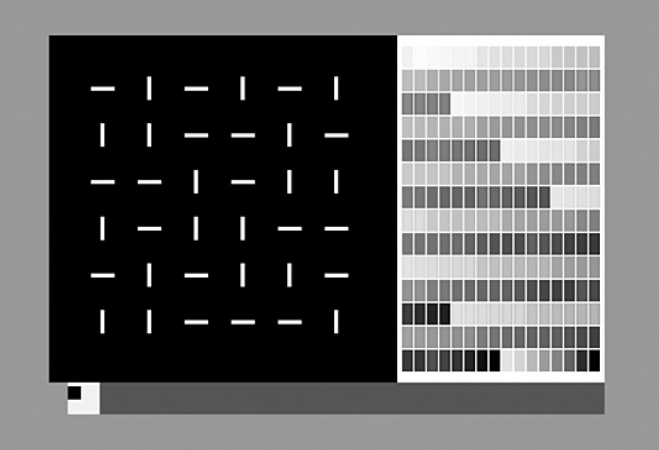Maths in Motion
Mathematical concepts in experimental film and video. The title of the film/video show is a paraphrase of an influential manifesto by the Hungarian Bauhaus master and constructivist Lászlò Moholy-Nagy, which was first published posthumously in 1947: "Vision in Motion". The "strict" spirit of mathematics is ostentatiously put in the place of "artistic" vision, proving that artistic aspiration and mathematical conception and precision are by no means opposites.
MATHS IN MOTION accompanies and expands the exhibition "Abstraction Now", in which non-representative contemporary art is presented. In contrast to the exhibition, in which only contemporary artistic positions are represented, the film/video show presents works from the beginning of experimental cinema to the present day, which are grouped thematically to provide an overview of the diverse developments of mathematical approaches in experimental film and video. The topic of abstraction is an important aspect of the field, but is supplemented in order to be better classified as a phenomenon in a broader (media) historical context. Although there are strong parallels in the history of modern fine art and the experimental moving image, these disciplines each obey their own laws. We want to take this insight into account with the historical orientation of the film/video show.
MATHS IN MOTION spans a period from the 1920s to the present day, with the ten programs arranged thematically rather than chronologically. The direct juxtaposition of historical and contemporary works creates connections that have never been seen before. In the direct encounter between the decades, the similarities as well as the further developments in technical and formal terms and, as a result, the sometimes strongly divergent styles clearly emerge. Uncovering continuities in the history of ideas in the artistic-experimental use of imaging technologies seemed more important and interesting than a mere chronological sequence or a media-technological categorization.
For experimental film and video art, operating with mathematical concepts means a cinema in which form is the primary design element. On the one hand, we are immersed in the objectless world of geometry, in which the simple form of the square is one of the primal cells, as in Malevich's work. For him, it was "the liberation of the arts from natural forms in order to be able to speak their own language." Rhythm becomes the most elementary creative tool, concentrating on what is essential to film: movement and light. The audience is left with its own world of imagination, the pure sensation of audiovisual perception.
On the other hand, this program presents works that are dedicated to the fascinating exploration of seeing in the broadest sense. These include those that investigate the phenomenon of time in film, use metric concepts to organize real image sequences or demonstrate the influence of the cinematographic apparatus, the carrier material or, more recently, the hardware and software of the computer. Graphic scores as a template for montage, comparable to musical recording systems, often create a serial character that works with loops and repetitions.
Especially in Vienna in the 1990s, a lively scene developed that explored the latest technologies for artistic purposes. Collaborations between electronic musicians, composers, graphic designers and video artists have given rise to videos committed to abstraction and geometry, perceptual investigations (condensations, fragmentations, superimpositions, etc.) as well as works that address chaos in the calculable (Tina Frank, Billy Roisz) or structuring through numbers and series (Mary Ellen Bute, Jürgen Moritz, Norbert Pfaffenbichler, reMI, Lotte Schreiber).
In this program series, the emotional gesture is replaced by the clarity and logic of construction. We can guarantee that these conceptually mature works are also visually fascinating and at the same time stimulate the desire to discover the formal patterns of order.
program overview
Calculated Movements
The Process of Abstraction
Structural Landscapes
Vectors & Coordinates
Chance, Chaos and Order
Structured Documents
The love of geometry
See the Rhythm!
Shaped time
Electronic Linguistics
see downloads for detailled program and more information
Eine Veranstaltung von sixpackfilm
Konzeption, Filmauswahl & Redaktion Brigitta Burger-Utzer, Norbert Pfaffenbichler, Gerald Weber

